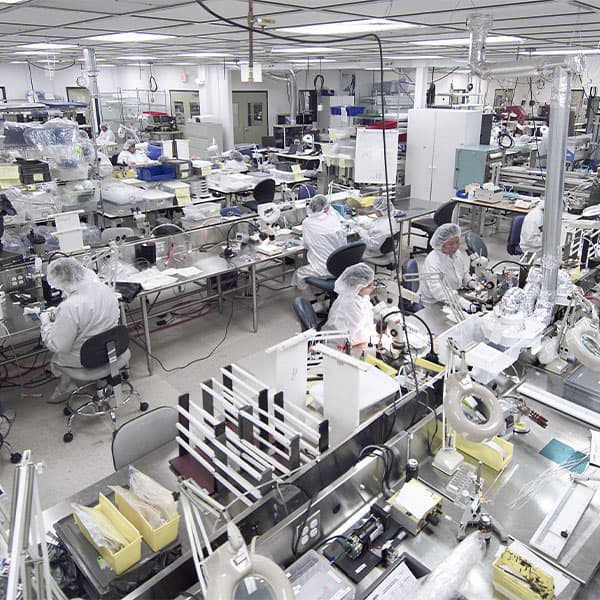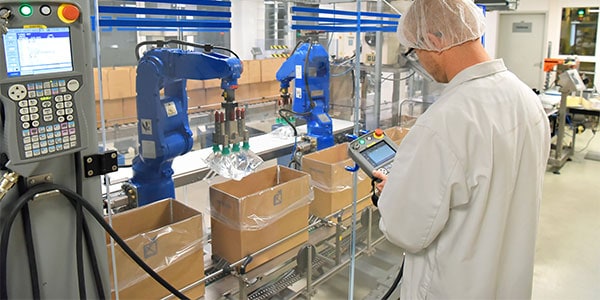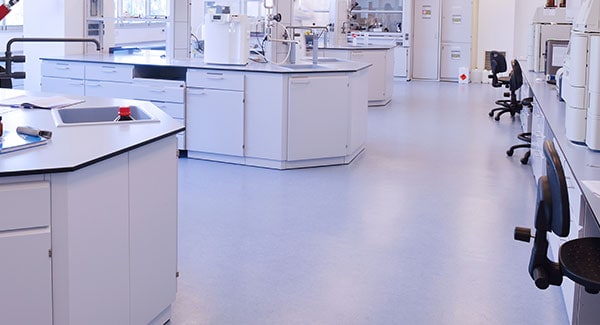
Medical Manufacturing
Medical manufacturing demands safe, reliable flooring. A floor coating that fails to meet Joint Commission Standards, proves hazardous to employees, or resists sterilization puts the entire facility at risk.
How do you know if your current floor coating offers you the safety and reliability you need? Does the product you have follow current health and safety standards? And if you do need to replace your floor covering, where can you find the money for an upgrade?
Is Your Medical Device Manufacturing Plant’s Floor Safe?
Safety first is the key rule in any manufacturing cleanroom. For a medical device manufacturer, safety means more than injury prevention. It refers to process and product safety along with worker safety.
Process Safety
The medical device production process requires an exceptional level of cleanliness. In facilities that work with biologics, for instance, infectious agents such as viruses can contaminate surfaces, increasing threat levels for employees. BioSafety Levels set the maximum viable particle count for keeping facilities safe and hygienic. Besides, regulatory agencies in nearly 200 countries set national standards for particle counts.
To maintain required standards of cleanliness in these conditions, floors, walls, and ceilings require regular attention. So these surfaces need to be easy for your staff members to clean. The best products consist of smooth, hard, and non-porous surfaces, which make cleaning and disinfecting simple.
Besides being easy to clean, floors also have to stay smooth and free of cracks and open joists. If your floor shows signs of wear and tear, it might be time for an inspection by an industrial flooring specialist to see if a new coating is right for you yet.
Product Safety
The products manufactured at most medical device plants must pass rigorous scrutiny to make sure they’re safe for the marketplace. Specific requirements for cleanliness vary by product, but they usually include a controlled, sometimes sterile, environment that ensures product quality and reliability.
Coupled with other industry-wide shifts in pharmaceutical manufacturing, heavy regulations appear poised to change the way the industry operates. Observers expect small production companies to start producing low-volume batches of multiple products instead of pumping out mega doses of popular drugs as they’ve done in the recent past.
While it’s probably necessary to remain solvent, this change elevates a company’s overall risk. With more products to manage and more regulations to adhere to, medical manufacturing companies face growing concerns around their ability to maintain safety standards and maximize product reliability.
Worker Safety
As always, people’s safety takes pride of place.
Workers need slip-resistant floors to reduce falls and associated injuries. Certainly a floor that’s often wet can be a hazard for employees, but even a dry floor can trip up a worker if it’s cracked, old, or improperly maintained.
Static electricity poses another concern to medical manufacturing workers. In some environments, just a shoe rubbing the floor can ignite a single spark with unintended, but severe, consequences.
Finally, your workers should be able to stand and walk on a comfortable floor that doesn’t hurt their feet, legs, or back. Injuries on manufacturing floors can dampen morale, reduce productivity, and even result in lawsuits and fines.
Worker safety concerns more than liability and human resource costs. A safe environment encourages a positive workplace culture that impacts the bottom line. Taking common-sense employee safety measures can help prevent accidents, injuries, and illnesses.
Flooring Safety Guide for a
Medical Supply Manufacturing Facility
Flooring needs in a medical manufacturing plant can grow complex. While worker satisfaction may top the list of concerns, manufacturers have to consider regulatory agency requirements and budgets when choosing which flooring to install and when to upgrade it.
Does your floor meet or exceed current health and safety standards? These standards vary depending on the product your company creates, and in some cases, on the area where you do business. In general, however, floors need to stay free of holes, splinters, loose boards, and protruding nails.
In a medical manufacturing setting, floors should appear clean, reduce noise, and support the building’s aesthetic. They need to feel comfortable to walk on, resist heavy stains, and endure significant wear and tear from both people and objects. Most importantly, of course, manufacturing floors need to be easy to clean, disinfect, and maintain.
During the COVID-19 pandemic, new concerns about safety flooded both the general population and manufacturers with large teams working together in a room. Wayfinding grew in popularity as did stickers that helped employees and patients know where to stand to maintain appropriate social distancing. And disinfecting all hard surfaces has never felt more critical.
That’s one reason many medical manufacturing companies are applying for government funds to help bring their facilities up to higher standards. While capital spending has slowed to a crawl in other sectors, medical manufacturers are increasing their output and supporting the medical industry as its staff members deal with COVID-19.
When is the last time you or your regulatory representative made a tour of your plant’s floors? Can you say for sure that your facility meets these standards? If so, that’s terrific! Check it off until next year. But if not, an industrial flooring specialist from CPC Floor Coatings can conduct an assessment for you.

Costs of Floor Covering for Medical Equipment Manufacturing
No one has access to unlimited funds, and floors usually comprise a fraction of an organization’s construction budget. Nevertheless, given the critical value of floors to process, product, and worker safety, perhaps floors need more consideration.
First, any company considering a new floor should think about durability and sustainability. Floors that last cost less in maintenance and repair. Resinous floor coatings such as Epoxy and polyurethane typically provide the practical, durable, reliable, and easy-to-clean surface that medical equipment manufacturers need. Facility engineers and flooring companies also need to consider the environmental regulations surrounding LEED accreditation when choosing a floor coating.
Then, financial factors come into play. Budgets are real, and you have to be reasonable. We get that. CPC can help you strike the right balance between prioritizing choices that affect safety, production, and regulatory compliance while staying as cost-effective as possible.
At CPC, we use the best products available to get the results you need. Our coating systems are made to last and our installation process is thorough and correct, every time. We will work with your production schedule to ensure the minimal downtime you need, and many of the processes we use enable us to work dust-free, cutting down installation time considerably.

Ready to get started?
If you’d like to talk with one of our experienced flooring specialists about your medical manufacturing plant’s cleanroom floor, contact us now. We’d love to work with you.
